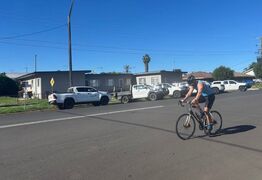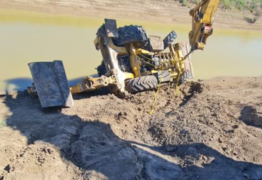'Starving artist' trope still relevant but there are exceptions
Lily Plass
19 April 2025, 9:40 PM
 Jenny Greentree with her latest artwork. Photo: supplied
Jenny Greentree with her latest artwork. Photo: suppliedWorking as a practitioner in the arts industry is a tough gig but some artists are showing it's still possible to make a living.
A study from the Royal Melbourne Institute of Technology (RMIT) said that artists are abandoning the sector due to a lack of opportunities.
The average income from a visual art or craft practice was $13,937, according to a recent RMIT study among art and craft workers.
“Funding is going to large arts organisations and established galleries while struggling individual artists can only get smaller grants," lead author Professor Grace McQuilten said.
"Much like workers in the gig economy, artists and arts workers often don’t know which awards and agreements they're covered by, if any.”
Arts Outwest CEO Kylie Shead agrees that times are tough for artists.
"It's harder than ever. Governments are cutting budgets, and that will affect the arts in an ongoing way," Ms Shead said.
The cost-of-living crisis is driving consumers away from spending money on what they consider luxuries.
According to the 2024 RMIT survey among art and craft workers, 63 percent reported feeling very or moderately stressed about their ability to pay for essential goods and services.
Since the COVID pandemic, the arts industry still hasn't made a full recovery, Ms Shead said.

Kylie Shead. Photo: ArtsOutWest
"Audiences don’t buy tickets early and performances get cancelled because people can't risk moving forward.
"We've seen that with festivals and events and that all flows into the arts industry in general.
"Often arts get cut in schools and then there's a perception that it's not as important as sports or other activities when, of course, we know having an arts background is absolutely essential for children to grow up and become creative thinkers."
Ms McQuilten said increasing funding for art education will have positive flow-on effects.
"Boosting investment in visual art and craft education leads to higher incomes and more jobs for artists and arts workers," Ms Mcquilten said.
"Most artists are not full-time. Many are also teachers, arts administrators, or they work on a farm, as well as having an art practice," Ms Shead said.
Nineteen years ago, Jenny Greentree left her job as a school teacher and opened the Back O' Bourke gallery.
Since then, she hasn't looked back.
"I think that artists can start their own businesses and galleries, particularly in the outback.
"We've been successful for the past 19 years but it all depends on if you can find your market," Ms Greentree said.
"There's some terrific wonderful artists out there who just haven't found the people to buy their art."
Despite living in a remote area, Ms Greentree managed to establish and grow her clientele through articles in local and national publications, and learning from her peers.
"We learned that from studying galleries out in Broken Hill and Lightning Ridge.
"A lot of people say to me they are glad to have found real Australian art."
Ms Greentree said if tried to live solely off of selling originals, she would still have to work as a school teacher for her main income.
"My reproductions are my bread and butter and selling my originals is like the cream on top.
"There are fewer galleries around because of the global financial crisis and Coonamble, and the increased cost of keeping galleries open so, we've been thankful every day that we've been able to stay open and even grow."



